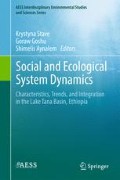Abstract
Agriculture is the mainstay of the Ethiopian economy in general and Lake Tana Sub-Basin in particular. The crop diversity in the Sub-Basin is high and the crop categories including cereals, legumes, root crops, oil crops, vegetables, fruit crops and other cash crops. The cropping pattern is also including the rain-fed , irrigation , residual moisture and minor recession cropping. More than 80% the cultivated land during the base-year is under rain-fed system and the remaining land is cultivated using irrigation and residual moisture. The farming system is characterized by crop-livestock mixed production system ; crop production is the focus of farmers both for food and cash income. In recent years agriculture has shown a sustained increase in the use of improved inputs notably seed varieties and chemical fertilizer, pesticides and farm credit. In the Sub-Basin areas, horticultural crop production is a relatively new activity which is mainly triggered by the commencement of small scale irrigation scheme. Studies in area revealed that insect pests and diseases were, and still are, one of the major production constraints. Farmers also ranked pest problems are to be one of the major production constraints in the area.
Access this chapter
Tax calculation will be finalised at checkout
Purchases are for personal use only
References
ANRS BoA (Amhara National Regional State Bureau of Agriculture) (2013) Community-based integrated natural resources management project in Lake Tana sub-basin. In: Baseline Report on Crop Production, Vol 8, TCS, Bahir Dar
Azanaw A, Merkuz A (2014) Gender mainstreaming in agricultural extension: implementation and constraints in Amhara Region, Fogera District, Ethiopia. Pacesetter J Agri Sc R 2(3):25–35
Fentahun T, Dagninet A, Merkuz A (2014) Evaluation of single yoke implement, harnessed and drawn by horse for cultivation of farm lands in north-western Ethiopia. WebPub J Agr Res 2(3):38–46
Getaneh K (2011) The impact of selected small-scale irrigation schemes on household income and the likelihood of poverty in the Lake Tana Basin of Ethiopia. Cornell University, Thesis
Merkuz A, Getachew A (2012a) Distribution and severity of sorghum covered kernel smut in North Western Ethiopia. Inter J Curr Res 4(04):041–045
Merkuz A, Getachew A (2012b) Evaluation of improved and local/landrace/sorghum varieties for covered kernel smut. Arch Phytopathol Plant Prot 45(6):717–723. doi:10.1080/03235408.2011.595904
Merkuz A, Seid A, Chemeda F et al. (2011) Effect of mustard green manure and dried plant residue on chickpea wilt (Fusarium oxysporum f.sp.ciceris). Arch Phytopathol Plant Prot (Taylor and Francis) 44(9):821–831. doi:10.1080/03235408.2010.490390
Monteiro CA (2003) WHO fruit and vegetable promotion initiative—report of the meeting. Paper presented Geneva, 25–27 August 2003
Simitu P (ed) (2005) Utilization and commercialization of dry land indigenous fruit tree species to improve livelihoods in East and Central Africa. In: Proceedings of a Regional workshop, KEFRI Kitui, Kenya 20–24 June 2005
Taddesse A (2006) Current land management in Lake Tana watersheds: Future challenges and opportunities for sustainable land management. In: Proceedings of the national consultative and promotional workshop on Lake Tana and its environs: Conservation, utilization, development and threats, EPLAUA, Bair Dar, 6–7 Nov 2006
WHO (World Health Organization) (2005). Fruit and vegetables for health. Report of a joint FAO/WHO Workshop, 1–3 September 2004, Kobe, Japan. http://www.fao.org/ag/magazine/fao-who-fv.pdf. Accessed 4 June 2015
Author information
Authors and Affiliations
Corresponding author
Editor information
Editors and Affiliations
Rights and permissions
Copyright information
© 2017 Springer International Publishing Switzerland
About this chapter
Cite this chapter
Abera, M. (2017). Agriculture in the Lake Tana Sub-basin of Ethiopia. In: Stave, K., Goshu, G., Aynalem, S. (eds) Social and Ecological System Dynamics. AESS Interdisciplinary Environmental Studies and Sciences Series. Springer, Cham. https://doi.org/10.1007/978-3-319-45755-0_23
Download citation
DOI: https://doi.org/10.1007/978-3-319-45755-0_23
Published:
Publisher Name: Springer, Cham
Print ISBN: 978-3-319-45753-6
Online ISBN: 978-3-319-45755-0
eBook Packages: Earth and Environmental ScienceEarth and Environmental Science (R0)

